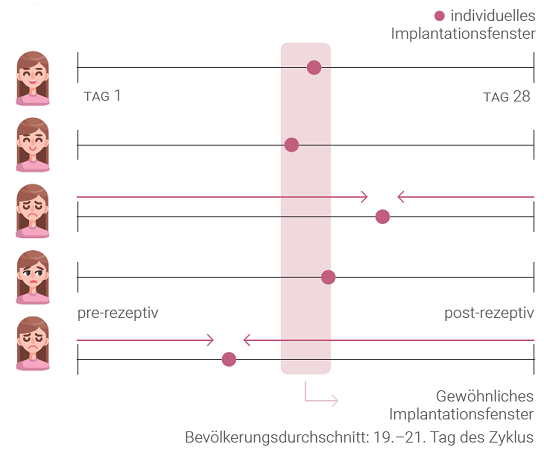Special laboratory methods
GENNET Endometrium Receptivity Test
GERT – GENNET Endometrial Receptivity test helps to determine the exact period of the menstrual cycle when the endometrial lining is properly receptive to the implantation of the embryo, the so-called implantation window.
GERT determines the ideal time for embryo transfer
The timing of the transfer is crucial for successful embryo implantation.
The basic prerequisite for a successful embryo transfer is the successful attachment of the embryo to the endometrium. The key factor for successful implantation is not only the quality of the embryos but also the time of the embryo transfer.
Endometrium is oblivious to the embryo (it does not allow the embryo to implant) for most of the menstrual cycle. But later, the endometrium becomes ideally receptive around 6th to 10th day after ovulation, and during these 4 - 5 days the so-called implantation window occurs - the time when the endometrium is most receptive to embryo transfer.
A regular ultrasound examination allows the endometrium to be evaluated only based on its height and structure. With the help of GERT, it is possible to look at the endometrium on a molecular level and precisely determine the implantation window.
Studies have shown that in almost a third of women, the endometrial implantation window is shifted compared to the average in the population. GERT can thus significantly increase the effectiveness of treatment with assisted reproduction methods.
Menstrual cycle
Implantation success rate in the case of embryo transfer Day 19-21 of the cycle (population average)
Who is the test intended for?
Various factors cause implantation failure and insufficient receptivity of the endometrium at the time of embryo transfer is just one of them. Therefore, we recommend GERT to women with repeated embryo implantation failures.
How the examination takes place
- Sampling
The examination is performed on an outpatient basis with no need for anesthesia. The doctor takes a small piece of tissue from the patient's endometrium, ideally in the cycle preceding the embryo transfer. The doctor inserts a thin catheter through the cervix and takes a sample. The procedure typically takes 10-15 minutes. - Sample analysis
The collected tissue is then subjected to molecular genetic examination. The results of the examination are compared with a prediction model that identifies the phase of receptivity the endometrium was in at the time the tissue was sampled. - Test results and subsequent recommendations
We can find out when the endometrium is properly receptive to the embryo through this examination.
The optimal time (day and hour) of the personalized embryo transfer is recommended to the patient based on the results.


